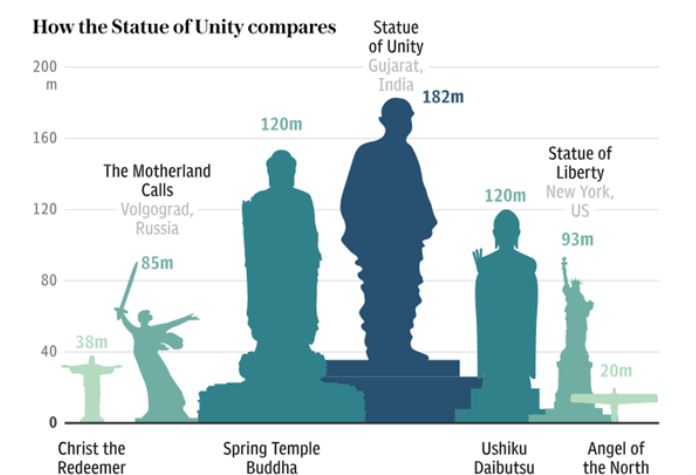All India Radio
Statue of unity – A tribute to Ironman
Search 31st October, 2018 Spotlight here: http://www.newsonair.com/Audio-Archive-Search.aspx
TOPIC: General Studies 1:
- Modern Indian history from about the middle of the eighteenth century until the present significant events, personalities, issues
- The Freedom Struggle – its various stages and important contributors /contributions from different parts of the country.
- Post-independence consolidation and reorganization within the country.
In News: On the 143rd birth anniversary of Sardar Vallabhbhai Patel, also known as the ‘Iron Man of India’, Prime Minister Narendra Modi has inaugurated the ‘Statue of Unity’, dedicated to statesman par excellence.
The Statue:
- On Sadhu Hill
- Standing at 182 meters in the middle of river Narmada at Kevadia in Gujarat’s Narmada district, the Statue of Unity is the tallest statue in the world– much taller than the 153 metre Spring Temple Buddha in China and almost twice the size of the Statue of Liberty in New York. (remember the places for Prelims)
- One can have a view of the Satpura and Vindhyachal mountain ranges, which also form the point where Madhya Pradesh, Gujarat and Maharashtra meet. (Prelims centric fact)
- Visitors can also get a distant view of the 12-km-long Garudeshwar Reservoir (which will help ensure there is always water around the statue), which is located downstream from the Narmada dam. (Prelims centric – location of the reservoir)
- Man Behind the Statue: Shri Ram Vanji Sutar, the 93-year-old sculptor.

Sardar Vallabhbhai Patel
The birthday of India`s Iron Man is being observed as Rashtriya Ekta Diwas or National Unity Day since the year 2014.
- First Deputy Prime Minister of India
- Widely considered to be the architect of modern India, Sardar Vallabhbhai Patel played an important role in the integration of all the princely states (especially Hyderabad, Junagadh and Kashmir) into the Indian Union after the British left India in 1947.
- Provided good governance as an able administrator in diverse fields like modern farming and empowerment of tribal communities
- Organised peasants from Kheda, Borsad, and Bardoli in Gujarat in non-violent civil disobedience against the British Raj, becoming one of the most influential leaders in Gujarat.
- He earned the title of “Sardar” after spearheading a no-tax campaign by peasants at Bardoli in Gujarat.
- He also led the relief and rehabilitation operations when Gujarat was ravaged by floods and worked tirelessly during a plague outbreak in Ahmedabad.
- He is also remembered as the “patron saint of India’s civil servants” for having established the modern all-India services system. “A civil servant cannot afford to, and must not, take part in politics. Nor must he involve himself in communal wrangles. To depart from the path of rectitude in either of these respects is to debase public service and to lower its dignity,” he had cautioned them on April 21, 1947.
Acknowledging the monumental contribution of Patel in nation building, Jawaharlal Nehru said, “History will call him the builder and consolidator of new India.”
The remarks Patel made during the Quit India Movement are also relevant today. He said: “We have to shed mutual bickering, shed the difference of being high or low and develop the sense of equality and banish untouchability. We have to live like the children of the same father”.
Must Read: Role of Sardar Vallabh bhai Patel in Uniting the Nation
Connecting the Dots:
- With great skill and masterful diplomacy and using both persuasion and pressure, Sardar Vallabhbhai Patel succeeded in integrating hundreds of princely states with the Indian Union. Discuss.
- Discuss the contribution of Sardar Patel from unification of the country to creation of all India services.












